Short notes on the 1977 Star Wars games
Quote from The Wargaming Scribe on 23 June 2023, 14h54Officially, the first Star Wars licenced game is The Empire Strikes Back for Intellivision and Atari 2600 in 1982 :
Wikipedia also mentions a non-official Star Wars game in 1978 on Apple II, but there were earlier games, and "earlier than 1978" can only mean 1977.
Thanks to Mobygames, Porkbelly and LanHawk in this thread and in email, we found 8 "early Star Wars" possibly written in 1977, though most were actually released in 1978.
By date of publication:==1977==
OSI Journal Oct Pg11 Star Wars
MECC STRWAR by Robb "Mithrandir" Borland==1978==
Kilobaud Feb pg52 Star Wars an exciting Apple-II graphics game by Robert J Bishop
Personal Computing Feb pg53 Play STAR WARS by Jerry Self
Peoples May pg11 STAR WARS by Mark Pelczarski
Creative Computing Sep pg134 Star Wars by Thomas N Ronayne
Softside Oct p33 Project Death Star
Creative Computing Software Star Wars by James Okamura - first mentioned in Creative Computing, November 1978, p97MECC STRWAR by Robb "Mithrandir" Borland
It comes straight from the Ralph Hopkins' collection, and is the reason for this short post. It is tagged as MECC and attributed in the code to Robb "Mithrandir" Borland and tagged as being finished the 4th of October, 1977 (with modification the 20th of March 1978).
Find the code here: https://www.sol20.org/ecb_programs.html
Find the emulator here: https://www.sol20.org/solace.htmlEven though it was only found on mainframe until its port on SOL-20 by Hopkins, and never sold commercially, it seems hard to beat as the "first" Star Wars game given the movie was released in May 1977. And yet...
OSI Journal Oct Pg11 Star Wars
Mobygames mentions an "October 1977" Star Wars game for the Ohio Scientific (a forgotten computer). It was found by Porkbelly in the Ohio Scientific Small Systems Journal.This is the earliest PUBLISHED Star Wars. Other may have been coded earlier (or not), but they were not released officially before 1978 (if ever, in the case of the one ported on SOL-20 by Ralph Hopkins.
Find the original code (typed by LanHawk) here
Find the emulator here: https://osi.marks-lab.com/#EmulatorFull listing below
Porbelly believes it was written for the OSI Superboard (single-board machine, with the video and keyboard hardware as add-on components). All the handwriting on the listing is according to him "surely an effort from someone to adapt the code to a OSI Challenger 1P (1978) or a Superboard with different hardware."
Kilobaud Feb pg52 Star Wars an exciting Apple-II graphics game by Robert J Bishop
(pending)
Personal Computing Feb pg53 Play STAR WARS by Jerry Self
- The February 1978 issue of Personal Computer includes a listing for a game called STARWARS by Jerry Self. The code states that the code was finished on the 3rd of October 1977, suspiciously one day before the Borland version.
Find the original code (typed by LanHawk) here
Find this code adapted to TRS-80 emulation by LanHawk here.
Peoples May pg11 STAR WARS by Mark Pelczarski
The People's Computer Company June 1978 issue includes another one, by no other than Marc Pelczarski (who had a Digital Antiquarian article just for him !). Again the code mentions "1977", and given that it also mentions that Marc was a teacher in High School, it means it was probably coded between September 1977 and December 1977 (given what we know of Marc's life).
Find the code (typed by LanHawk) here
Find this code adapted to TRS-80 emulation by LanHawk here
Creative Computing Sep pg134 Star Wars by Thomas N RonaynePendingSoftside Oct p33 Project Death StarPending
That's it ! Now I want to write AAR for those initial versions, starting with the Robb Borland version - because that's the one I have, and because I had written it for an article before realizing it was not a wargame in any possible acceptance !
Officially, the first Star Wars licenced game is The Empire Strikes Back for Intellivision and Atari 2600 in 1982 :
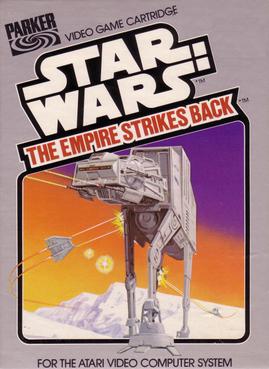
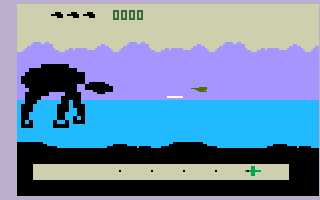
Wikipedia also mentions a non-official Star Wars game in 1978 on Apple II, but there were earlier games, and "earlier than 1978" can only mean 1977.
Thanks to Mobygames, Porkbelly and LanHawk in this thread and in email, we found 8 "early Star Wars" possibly written in 1977, though most were actually released in 1978.
By date of publication:
OSI Journal Oct Pg11 Star Wars
MECC STRWAR by Robb "Mithrandir" Borland
Kilobaud Feb pg52 Star Wars an exciting Apple-II graphics game by Robert J Bishop
Personal Computing Feb pg53 Play STAR WARS by Jerry Self
Peoples May pg11 STAR WARS by Mark Pelczarski
Creative Computing Sep pg134 Star Wars by Thomas N Ronayne
Softside Oct p33 Project Death Star
Creative Computing Software Star Wars by James Okamura - first mentioned in Creative Computing, November 1978, p97
MECC STRWAR by Robb "Mithrandir" Borland
It comes straight from the Ralph Hopkins' collection, and is the reason for this short post. It is tagged as MECC and attributed in the code to Robb "Mithrandir" Borland and tagged as being finished the 4th of October, 1977 (with modification the 20th of March 1978).
Find the code here: https://www.sol20.org/ecb_programs.html
Find the emulator here: https://www.sol20.org/solace.html
Even though it was only found on mainframe until its port on SOL-20 by Hopkins, and never sold commercially, it seems hard to beat as the "first" Star Wars game given the movie was released in May 1977. And yet...
OSI Journal Oct Pg11 Star Wars
Mobygames mentions an "October 1977" Star Wars game for the Ohio Scientific (a forgotten computer). It was found by Porkbelly in the Ohio Scientific Small Systems Journal.
This is the earliest PUBLISHED Star Wars. Other may have been coded earlier (or not), but they were not released officially before 1978 (if ever, in the case of the one ported on SOL-20 by Ralph Hopkins.
Find the original code (typed by LanHawk) here
Find the emulator here: https://osi.marks-lab.com/#Emulator
Full listing below

Porbelly believes it was written for the OSI Superboard (single-board machine, with the video and keyboard hardware as add-on components). All the handwriting on the listing is according to him "surely an effort from someone to adapt the code to a OSI Challenger 1P (1978) or a Superboard with different hardware."
Kilobaud Feb pg52 Star Wars an exciting Apple-II graphics game by Robert J Bishop
(pending)
Personal Computing Feb pg53 Play STAR WARS by Jerry Self
- The February 1978 issue of Personal Computer includes a listing for a game called STARWARS by Jerry Self. The code states that the code was finished on the 3rd of October 1977, suspiciously one day before the Borland version.
Find the original code (typed by LanHawk) here
Find this code adapted to TRS-80 emulation by LanHawk here.
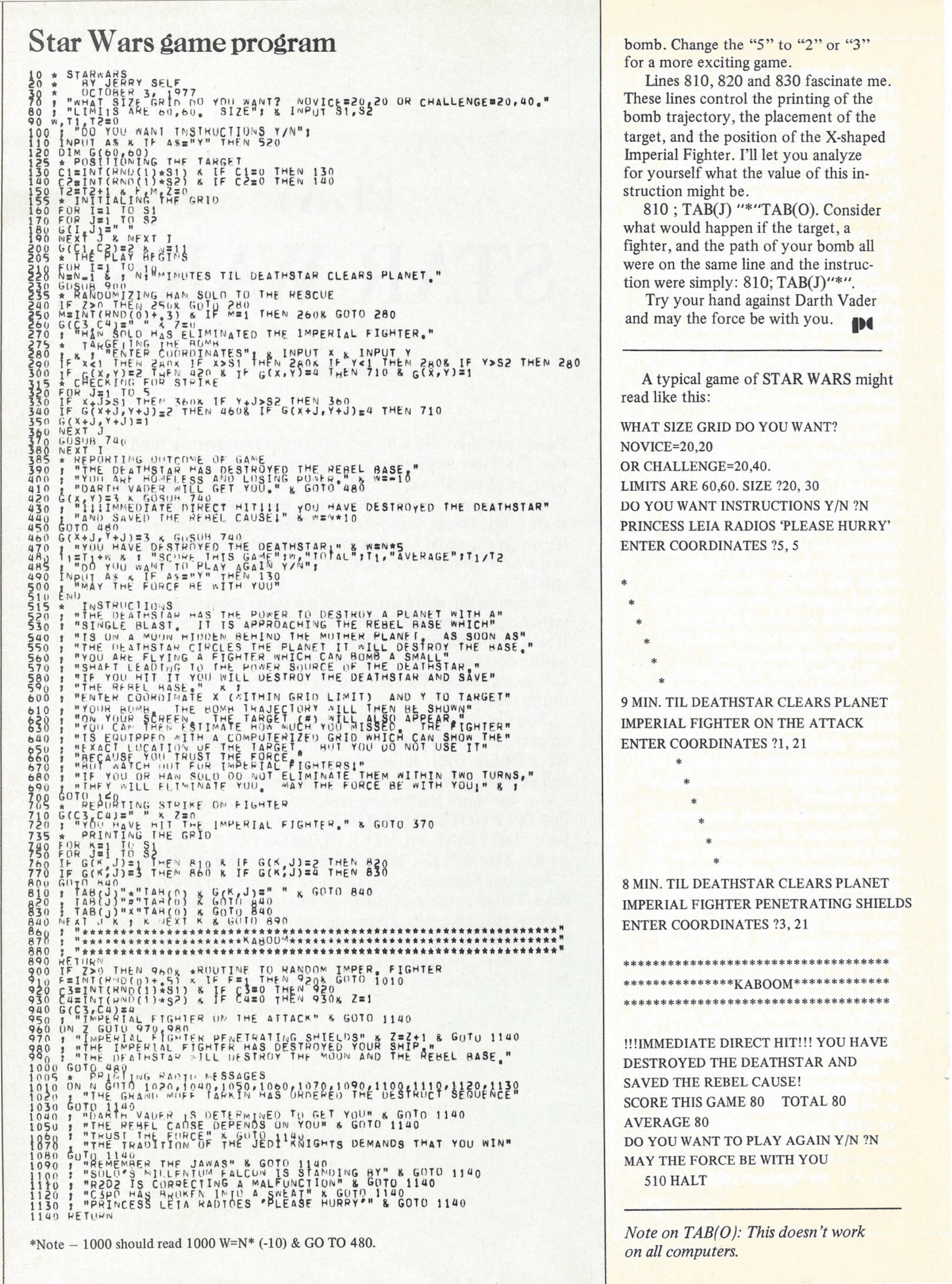
Peoples May pg11 STAR WARS by Mark Pelczarski
The People's Computer Company June 1978 issue includes another one, by no other than Marc Pelczarski (who had a Digital Antiquarian article just for him !). Again the code mentions "1977", and given that it also mentions that Marc was a teacher in High School, it means it was probably coded between September 1977 and December 1977 (given what we know of Marc's life).
Find the code (typed by LanHawk) here
Find this code adapted to TRS-80 emulation by LanHawk here
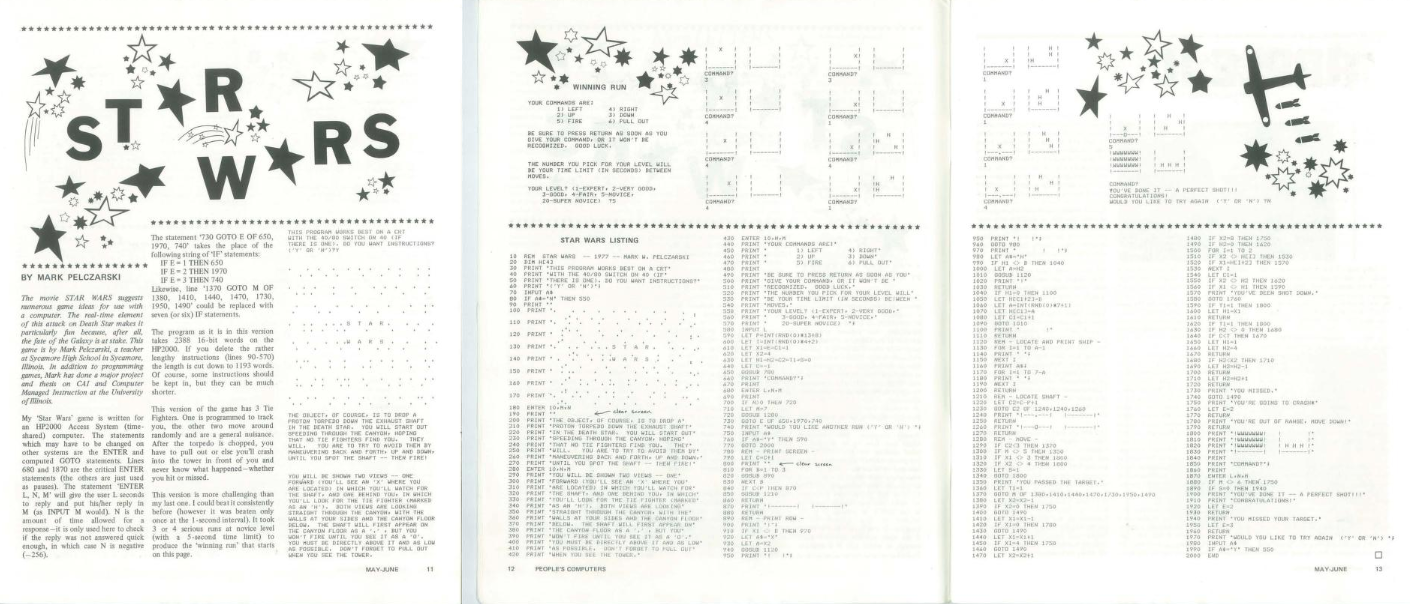
Pending
That's it ! Now I want to write AAR for those initial versions, starting with the Robb Borland version - because that's the one I have, and because I had written it for an article before realizing it was not a wargame in any possible acceptance !
Quote from The Wargaming Scribe on 23 June 2023, 14h58Robb Borland's STRWAR
Written by Robb "Mithrandir" Borland on a mainframe MECC computer in October 1977, modified in March 1978, ported to SOL-20 by Ralph Hopkins
STRWAR offers to the player to replay the iconic "trench run" of a famous 1977 movie by maneuvering "down a trench 500 000 feet long, 200 feet wide and 200 feet deep to a point 10 000 feet from the end of the trench and dead in the center of it".
The instructions are really long :
Long story short, you can be killed by :
- A turbolaser shooting every 10 seconds (= 1 turn) just through the middle of the trench,
- Random hit by turbo-lasers, which you cannot do anything about except go fast to reduce the time you stay in the trench,
- Hitting the border of the trench, obviously,
- Hitting the end of the trench, also obviously
- Getting shot down by Darth Vader,
In practice, the game is about choosing a direction and a speed every turn and being lucky with the turbo-lasers :
From time to time, Darth Vader appears behind you. but I found out that inverting the previous direction is in general enough to evade him :
Changing course every turn keeps the lucky player relatively safe and does not slow down the ship as it should. The unlucky player will just die by a random turbo-laser like that :
After a couple of attempts, I finally approached the final target :
At this point, it is time to go to the center of the trench :
Counter-intuitively, when in the middle of the trench at full speed, the player must then spend one more turn going straight ahead if they do not want to miss the exhaust port. They will be saved by a desperate last-second pull-up:
The player must now input an angle. Too sharp and the ship disintegrates like an early WWI plane. Not sharp enough and the ship hits the end of the trench. Checking the code, the angle must be between 1.66 and 10.
Mission accomplished ! For everyone in 1977, that's the end of the story. It was a happier time, without Ewoks and Jar-Jar Binks.
Robb Borland's STRWAR
Written by Robb "Mithrandir" Borland on a mainframe MECC computer in October 1977, modified in March 1978, ported to SOL-20 by Ralph Hopkins
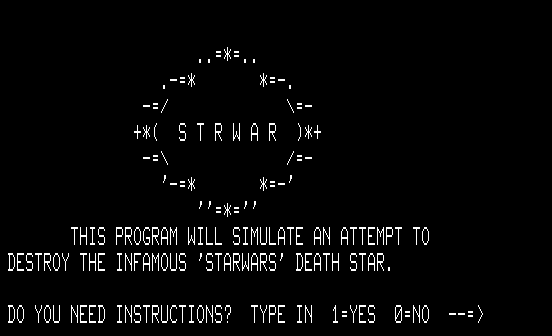
STRWAR offers to the player to replay the iconic "trench run" of a famous 1977 movie by maneuvering "down a trench 500 000 feet long, 200 feet wide and 200 feet deep to a point 10 000 feet from the end of the trench and dead in the center of it".
The instructions are really long :

Long story short, you can be killed by :
-
- A turbolaser shooting every 10 seconds (= 1 turn) just through the middle of the trench,
-
- Random hit by turbo-lasers, which you cannot do anything about except go fast to reduce the time you stay in the trench,
- Hitting the border of the trench, obviously,
- Hitting the end of the trench, also obviously
- Getting shot down by Darth Vader,
In practice, the game is about choosing a direction and a speed every turn and being lucky with the turbo-lasers :
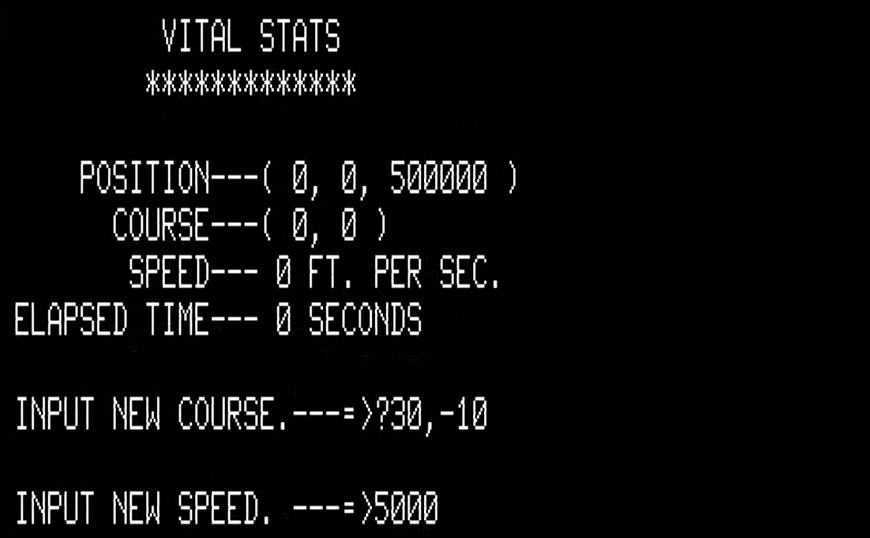
From time to time, Darth Vader appears behind you. but I found out that inverting the previous direction is in general enough to evade him :
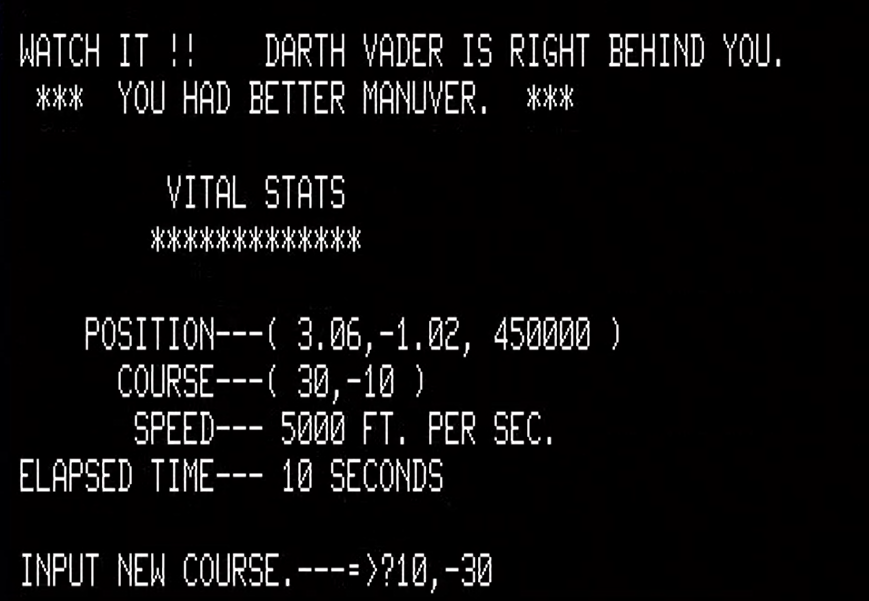
Changing course every turn keeps the lucky player relatively safe and does not slow down the ship as it should. The unlucky player will just die by a random turbo-laser like that :
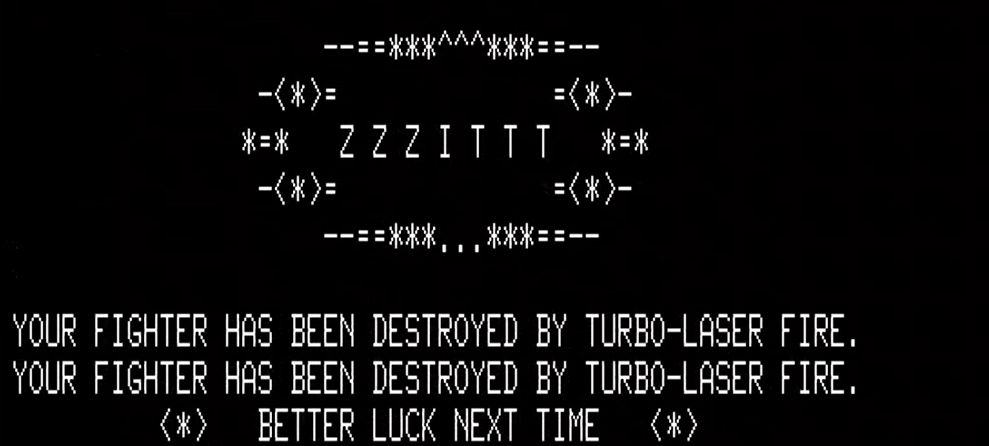
After a couple of attempts, I finally approached the final target :
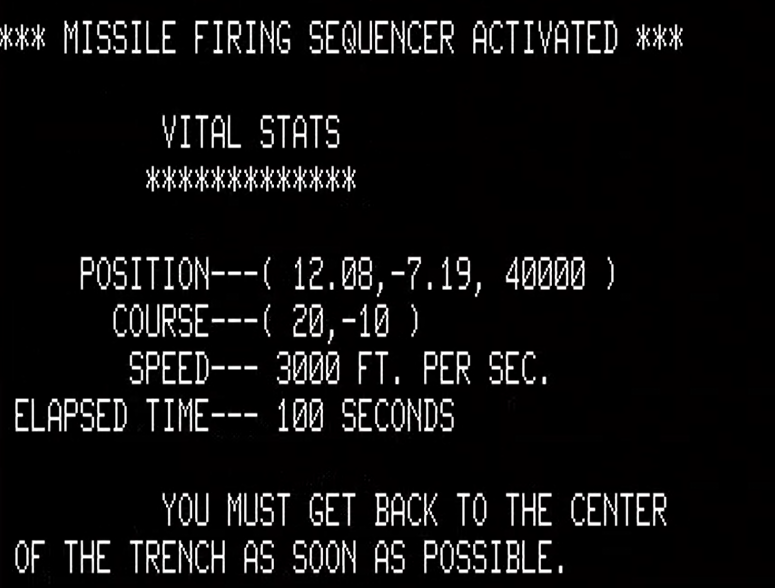
At this point, it is time to go to the center of the trench :
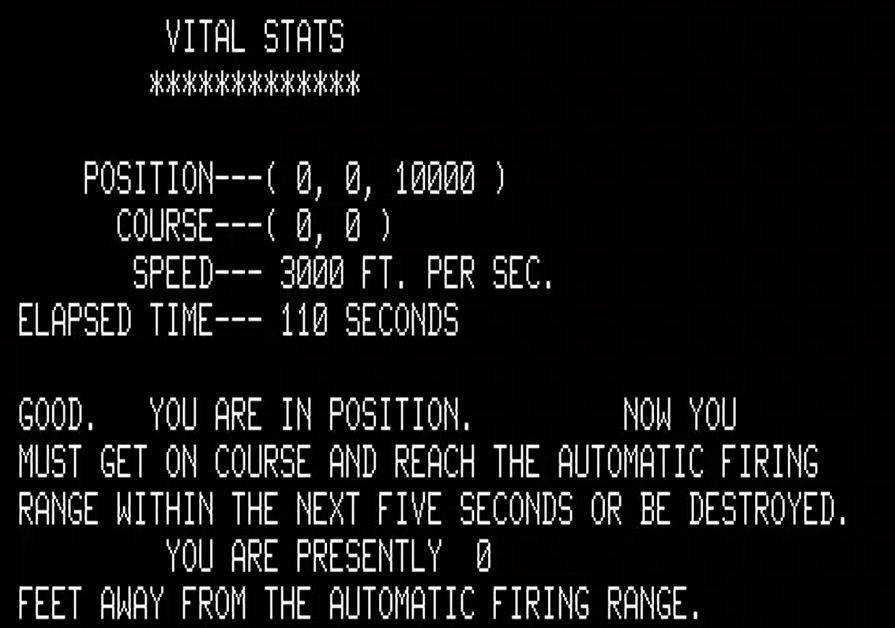
Counter-intuitively, when in the middle of the trench at full speed, the player must then spend one more turn going straight ahead if they do not want to miss the exhaust port. They will be saved by a desperate last-second pull-up:

The player must now input an angle. Too sharp and the ship disintegrates like an early WWI plane. Not sharp enough and the ship hits the end of the trench. Checking the code, the angle must be between 1.66 and 10.
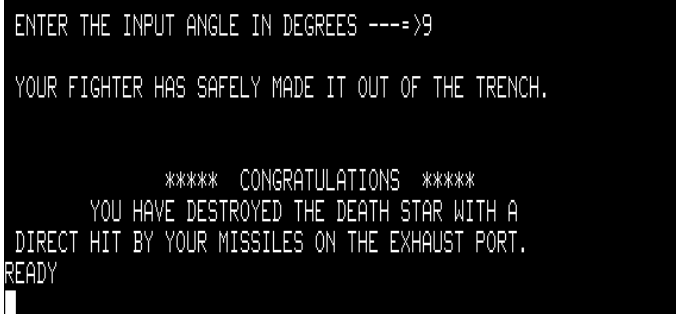
Mission accomplished ! For everyone in 1977, that's the end of the story. It was a happier time, without Ewoks and Jar-Jar Binks.
Quote from The Wargaming Scribe on 23 June 2023, 15h10Jerry Self's Star Wars
Found in Personal Computing, February 1978, typed and ported to TRS-80 by commenter LanHawk in June 2023
Before even explaining what I am supposed to do, the game requests me to input the size of the grid. What is it going to be used for ? Space Combat ? Infantry tactics ?
But of course ! The trench run, again !
... except without the trench because I can launch several bombs :
The way the game works is that you input coordinates (the vertical axis is written first, then the horizontal one, which confused me initially) and then check the trajectory of your bomb and compare it to the location of the Death Star (#) and of an eventual Imperial fighter (X).
It is slow, this is a GIF of an attack resolution below, but depending on "when" you look at it it may look like a screenshot 🙂
There is an enemy fighter out there, and it will kill me if I don't kill it first. Of course, I could also hit the Death Star the next turn and win the game, but the fighter is clearly on line 1 so I just need to get the horizontal right. I try to hit it :
That's the failure, and it is game over :
I retry again with the same difficulty settings. I start with the middle of the grid again (10,20) and notice that the Death Star is at the top. I then mix-up the two axis, and hit way too much to the left :
I am then lucky, because Han Solo shoots down the fighter, allowing me to focus on the Death Star. Great teamwork, Solo !
That was very close, and two turns later :
The Death Star is destroyed. Given the cost of the thing, I don't think the Empire will ever try to rebuild one !
Jerry Self's Star Wars
Found in Personal Computing, February 1978, typed and ported to TRS-80 by commenter LanHawk in June 2023
Before even explaining what I am supposed to do, the game requests me to input the size of the grid. What is it going to be used for ? Space Combat ? Infantry tactics ?

But of course ! The trench run, again !
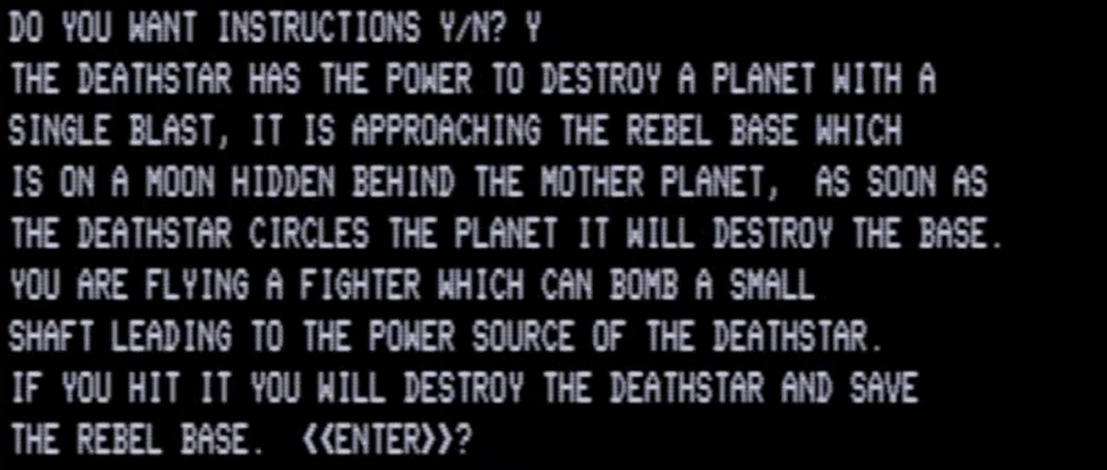
... except without the trench because I can launch several bombs :
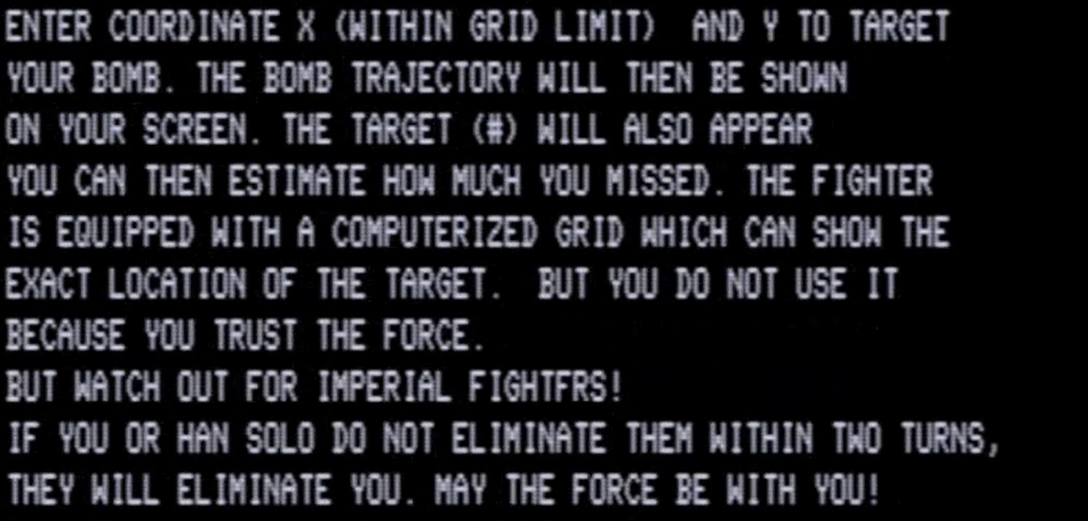
The way the game works is that you input coordinates (the vertical axis is written first, then the horizontal one, which confused me initially) and then check the trajectory of your bomb and compare it to the location of the Death Star (#) and of an eventual Imperial fighter (X).
It is slow, this is a GIF of an attack resolution below, but depending on "when" you look at it it may look like a screenshot 🙂
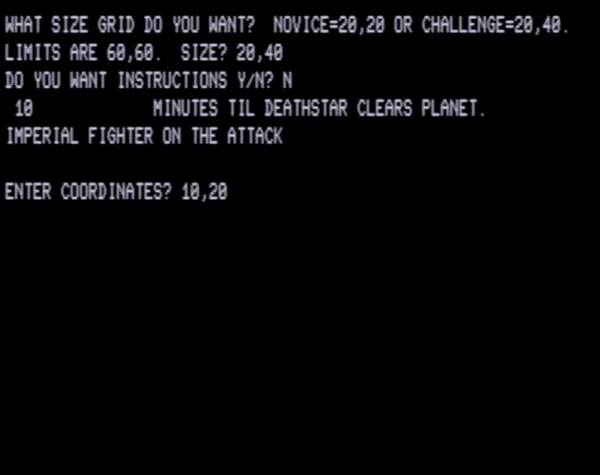
There is an enemy fighter out there, and it will kill me if I don't kill it first. Of course, I could also hit the Death Star the next turn and win the game, but the fighter is clearly on line 1 so I just need to get the horizontal right. I try to hit it :
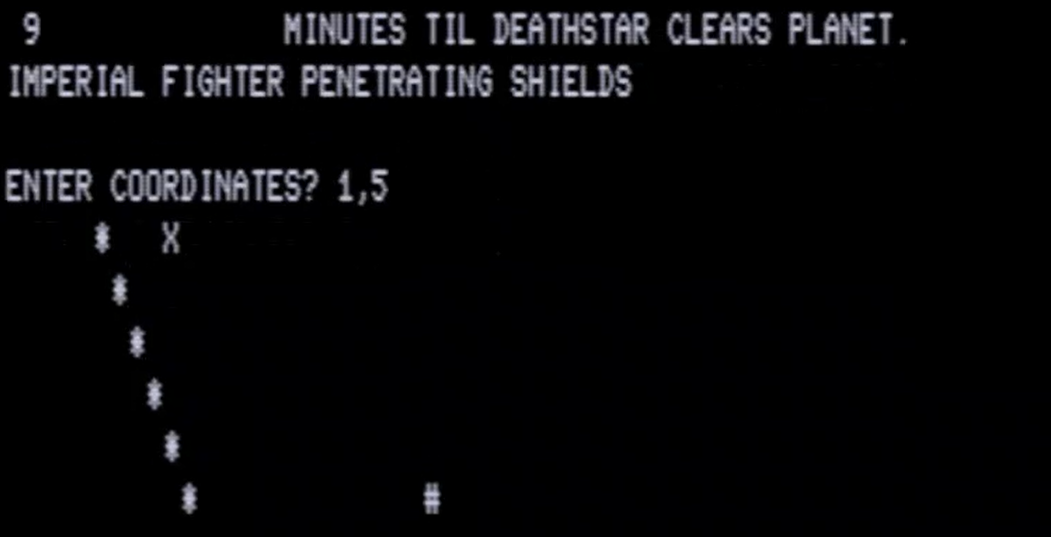
That's the failure, and it is game over :

I retry again with the same difficulty settings. I start with the middle of the grid again (10,20) and notice that the Death Star is at the top. I then mix-up the two axis, and hit way too much to the left :
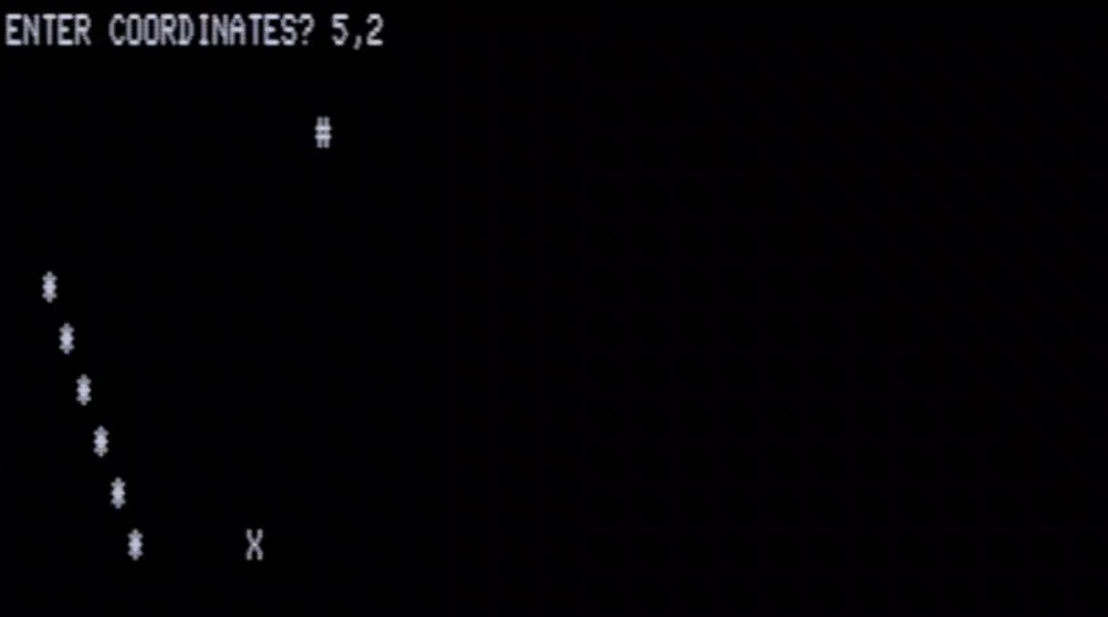
I am then lucky, because Han Solo shoots down the fighter, allowing me to focus on the Death Star. Great teamwork, Solo !
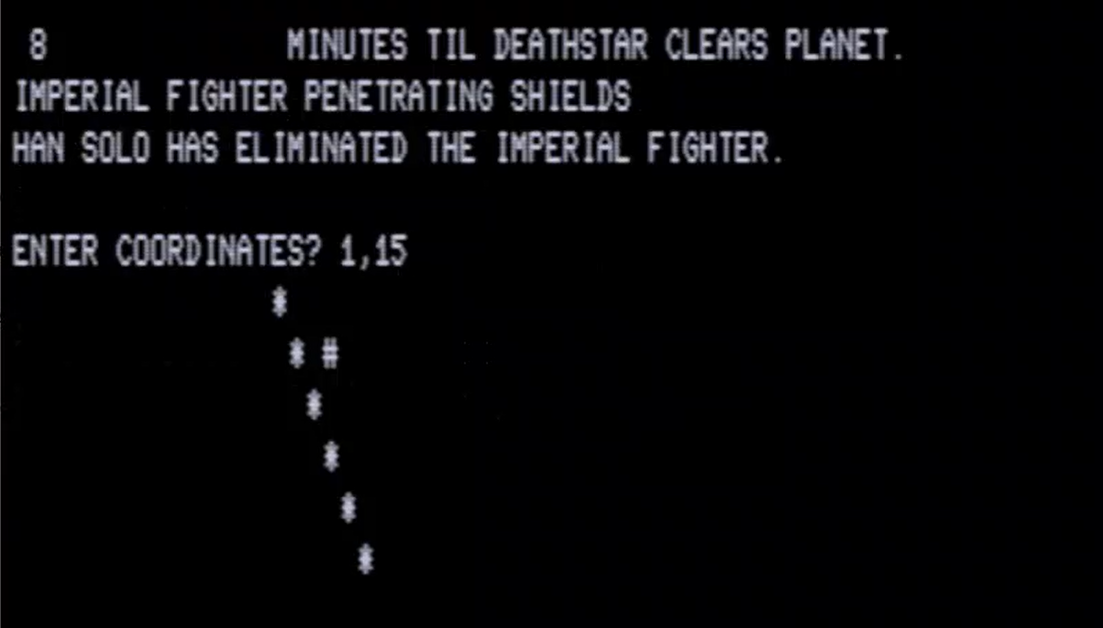
That was very close, and two turns later :
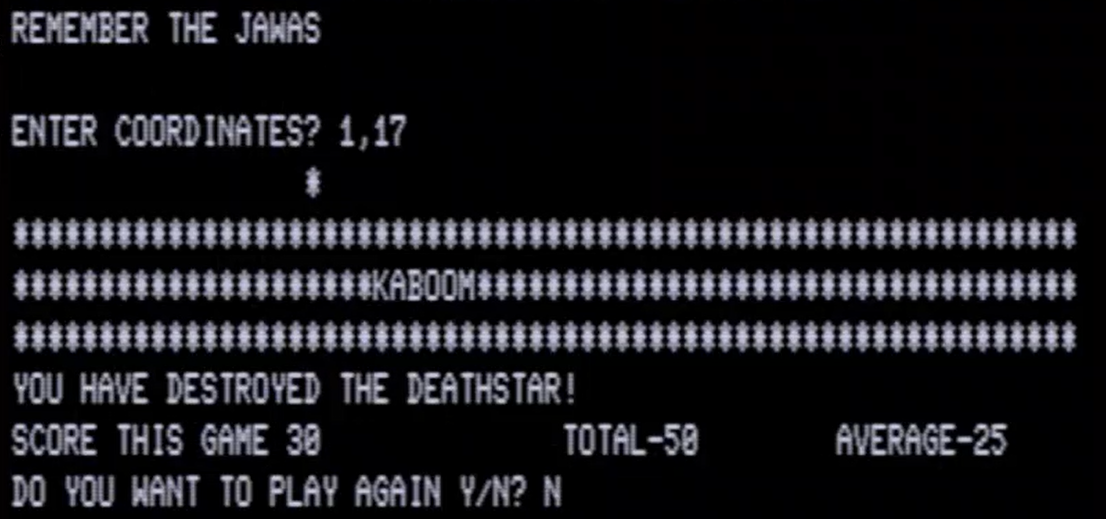
The Death Star is destroyed. Given the cost of the thing, I don't think the Empire will ever try to rebuild one !
Quote from The Wargaming Scribe on 23 June 2023, 15h18Marc Pelczarski's Star Wars
Found in the People's Computer Company, June 1978, typed and ported to TRS-80 by commenter LanHawk in June 2023
So many Stars ! It looks like it is going to be a strategic game à la Galaxy ...
...
but NO ! It's a trench run !
There are 6 commands and a lot of level of difficulties. I go for "Expert", because I am better than whatever they used for gaming in 1977 :
The game starts. I see in front of me (with my position relative to the trench represented as a "X") and behind me, with nothing at the moment :
After some time, enemy Tie Fighers appear behind me :
The game is about moving in a way that we never "end" with a Tie Fighter in my back. It is fairly trivial, though a bit long :
Eventually, I approach the ventilation shaft (the small "O") :
The only thing I need to do is press the key to send the bomb, and then the key to pull up
That's it ! No more Death Star ! I wonder how many they have like this.
Marc Pelczarski's Star Wars
Found in the People's Computer Company, June 1978, typed and ported to TRS-80 by commenter LanHawk in June 2023
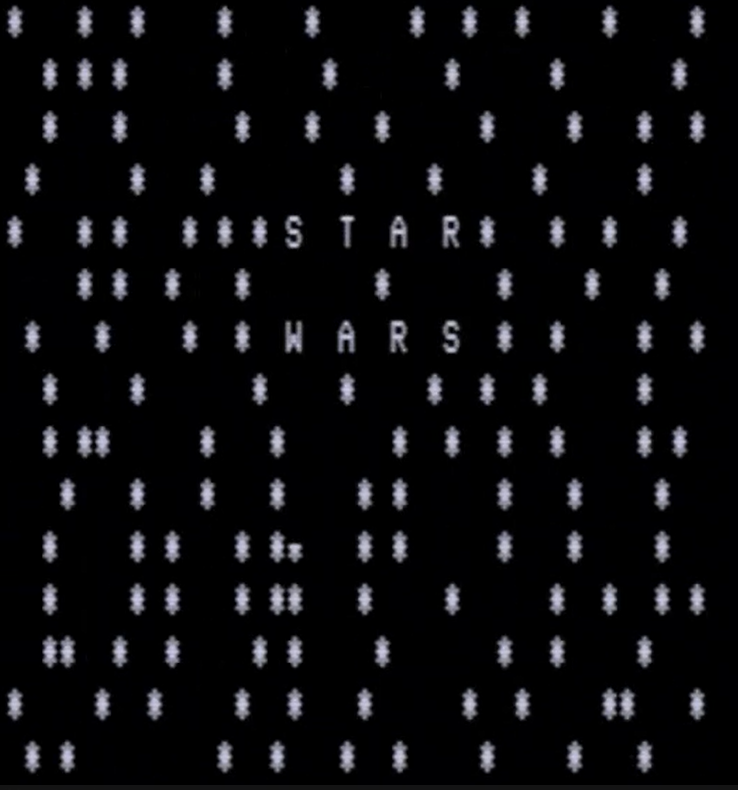
So many Stars ! It looks like it is going to be a strategic game à la Galaxy ...
...
but NO ! It's a trench run !
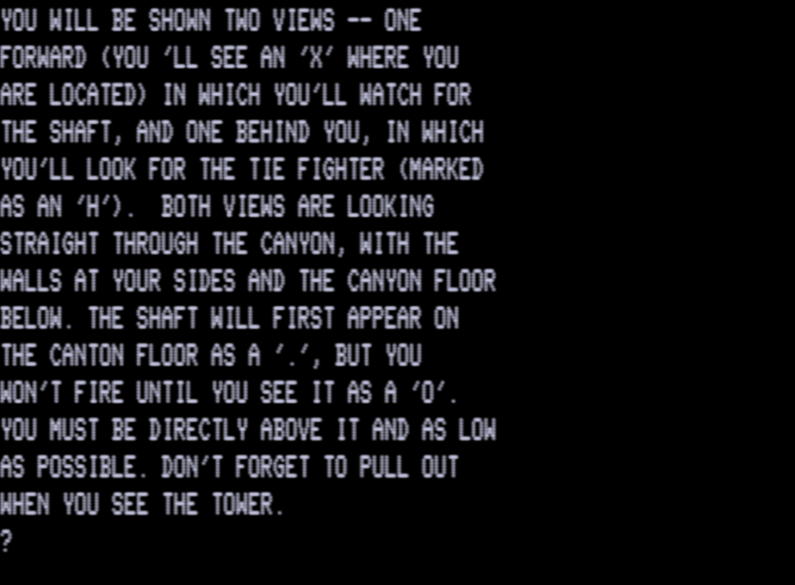
There are 6 commands and a lot of level of difficulties. I go for "Expert", because I am better than whatever they used for gaming in 1977 :
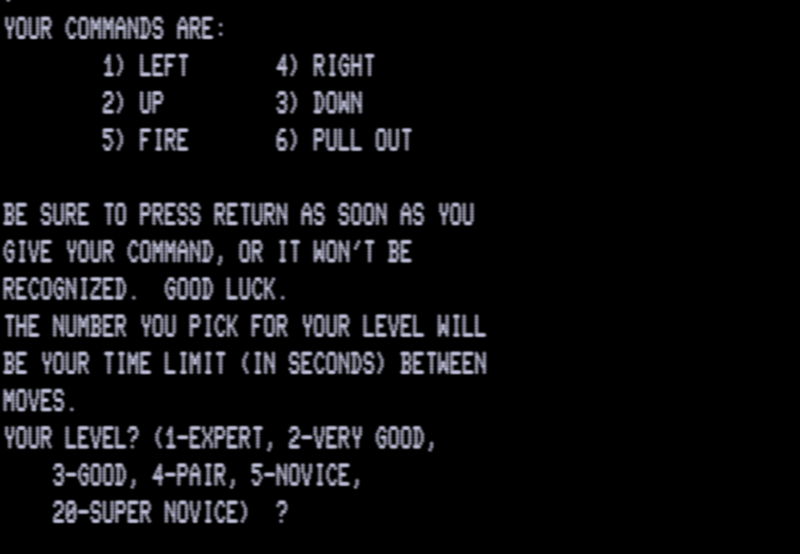
The game starts. I see in front of me (with my position relative to the trench represented as a "X") and behind me, with nothing at the moment :
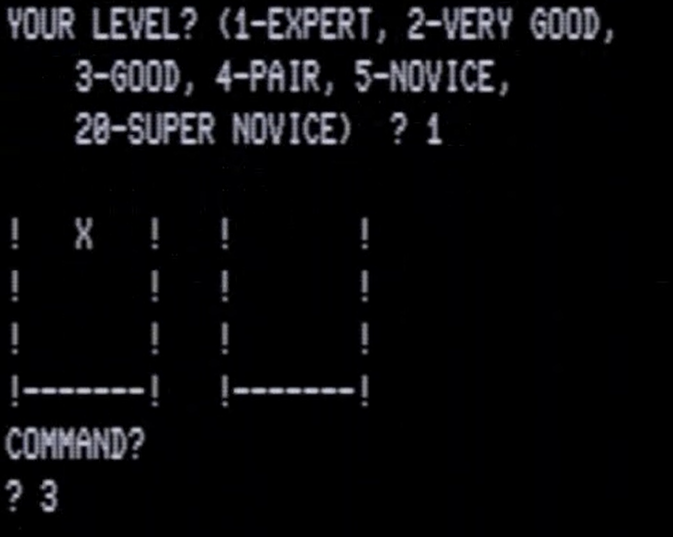
After some time, enemy Tie Fighers appear behind me :
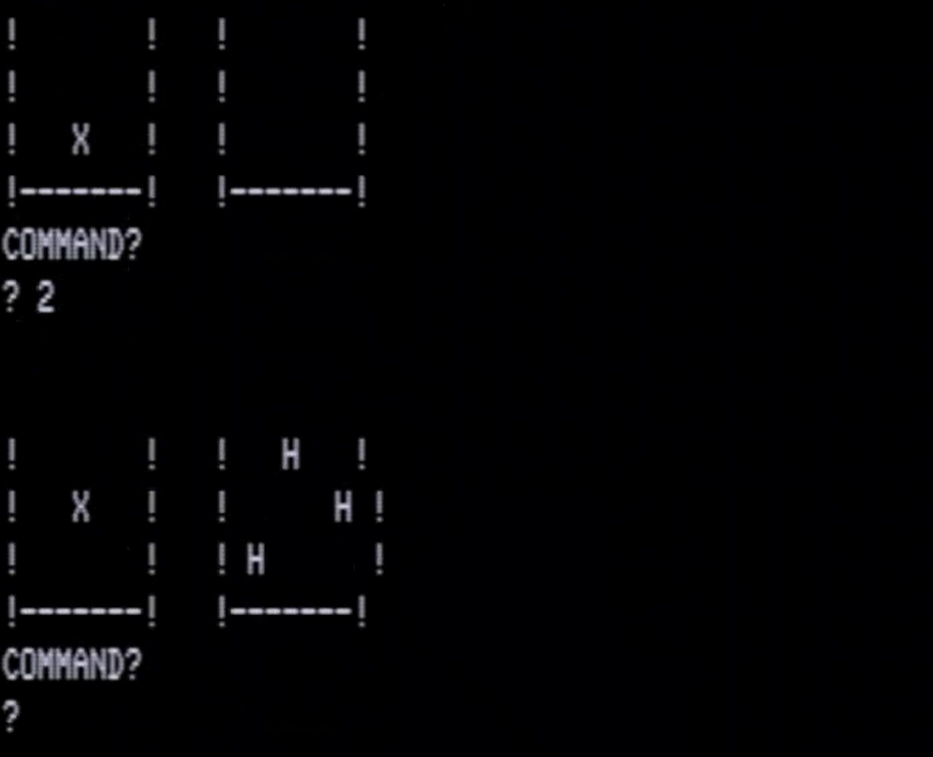
The game is about moving in a way that we never "end" with a Tie Fighter in my back. It is fairly trivial, though a bit long :
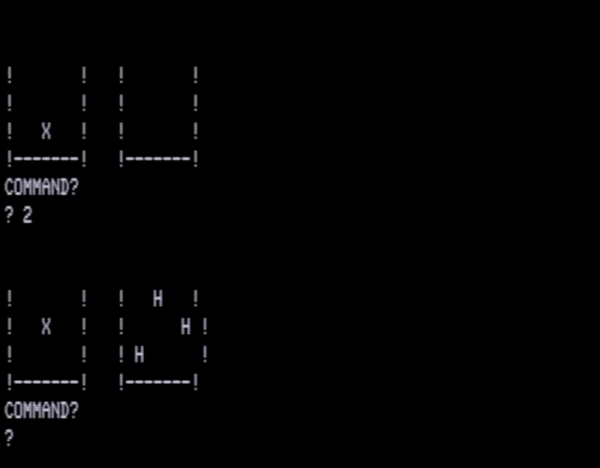
Eventually, I approach the ventilation shaft (the small "O") :
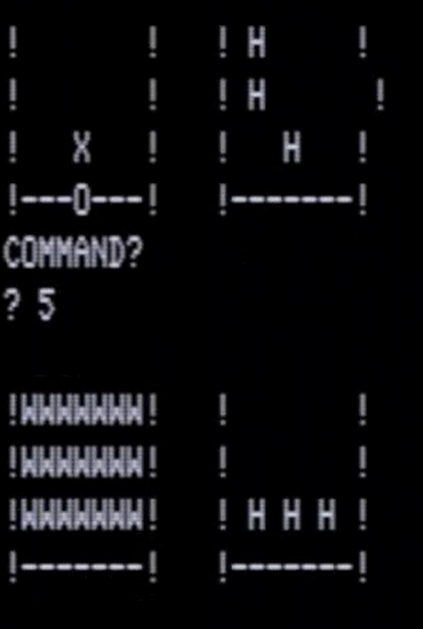
The only thing I need to do is press the key to send the bomb, and then the key to pull up

That's it ! No more Death Star ! I wonder how many they have like this.
Quote from The Wargaming Scribe on 23 June 2023, 15h19Robert L. Coppedge's Now You Can Play Star Wars (1977)
OK, I am not sure whether the name is "Now You Can Play Star Wars" or just "Star Wars" and Coppedge was saying you could finally play it.
Found in Ohio's Scientific's Small Systems Journal, October 1977. Typed by LanHawk. Emulation was a struggle (the game is largely irresponsive), so I am commenting a game done by Porkbelly.The game starts without any intro and is about shooting targets in real-time:
If you shoot down 5 enemies within the allotted time, you receive a congratulatory message:
You are actually more rewarded visually by a loss:
And well... that's all! It does not feel very Star Wars; at this level of narration, it could just as well have been Star Trek or Buck Rogers. Still, 1977 & real-time.
Robert L. Coppedge's Now You Can Play Star Wars (1977)
OK, I am not sure whether the name is "Now You Can Play Star Wars" or just "Star Wars" and Coppedge was saying you could finally play it.
Found in Ohio's Scientific's Small Systems Journal, October 1977. Typed by LanHawk. Emulation was a struggle (the game is largely irresponsive), so I am commenting a game done by Porkbelly.
The game starts without any intro and is about shooting targets in real-time:
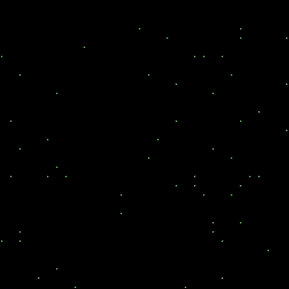
If you shoot down 5 enemies within the allotted time, you receive a congratulatory message:
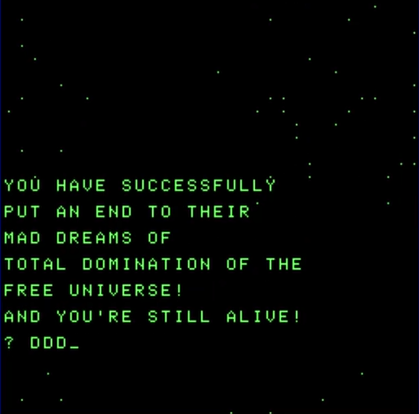
You are actually more rewarded visually by a loss:
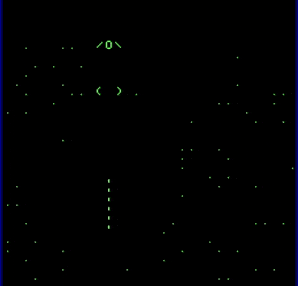
And well... that's all! It does not feel very Star Wars; at this level of narration, it could just as well have been Star Trek or Buck Rogers. Still, 1977 & real-time.
Quote from Porkbelly on 23 June 2023, 15h56Interesting! The OSI Star Wars is a simple type-in game from the OSI Small Systems Journal. Email sent.
Interesting! The OSI Star Wars is a simple type-in game from the OSI Small Systems Journal. Email sent.
Quote from Porkbelly on 23 June 2023, 16h22
For the Apple II there were a couple of game by Bob Bishop, which were available on cassette in 1977 by Computer Playground. Rocket Pilot and Star Wars. Both are action games, but notable, being early examples of using Apple II hi-resolution graphics. Bob Bishop was really a pioneer in the early days of Apple gaming.
Both of these games also appeared as assembly language type-in's in Kilobaud magazine, Rocket Pilot (Jan 1978) and Star Wars (Feb 1978). Rocket Pilot is more of a Lunar Lander type game, the only Star Wars relevance is the line art drawings of Luke and droids in landspeeder.
According to the first page of the Star Wars article (below), Bob wrote this on a Sunday afternoon in August of 1977.
For the Apple II there were a couple of game by Bob Bishop, which were available on cassette in 1977 by Computer Playground. Rocket Pilot and Star Wars. Both are action games, but notable, being early examples of using Apple II hi-resolution graphics. Bob Bishop was really a pioneer in the early days of Apple gaming.
Both of these games also appeared as assembly language type-in's in Kilobaud magazine, Rocket Pilot (Jan 1978) and Star Wars (Feb 1978). Rocket Pilot is more of a Lunar Lander type game, the only Star Wars relevance is the line art drawings of Luke and droids in landspeeder.
According to the first page of the Star Wars article (below), Bob wrote this on a Sunday afternoon in August of 1977.
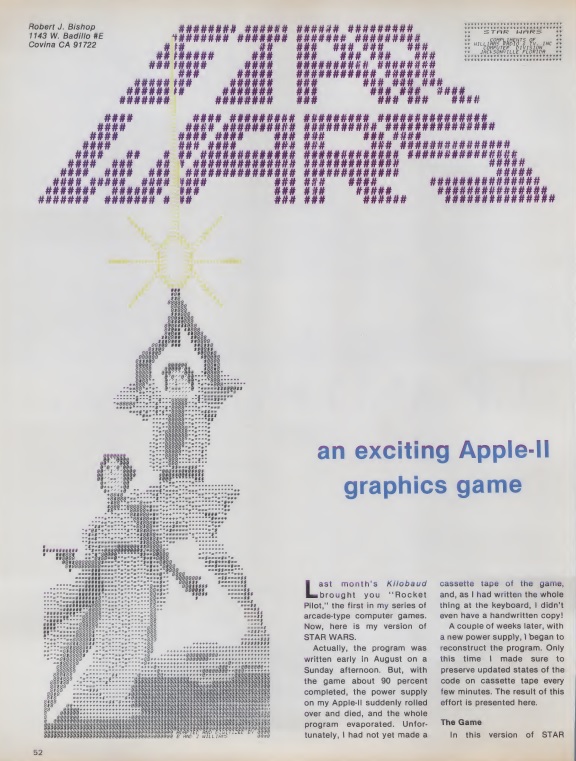
Quote from The Wargaming Scribe on 23 June 2023, 16h43Quote from Porkbelly on 23 June 2023, 16h22
For the Apple II there were a couple of game by Bob Bishop, which were available on cassette in 1977 by Computer Playground. Rocket Pilot and Star Wars. Both are action games, but notable, being early examples of using Apple II hi-resolution graphics. Bob Bishop was really a pioneer in the early days of Apple gaming.
Both of these games also appeared as assembly language type-in's in Kilobaud magazine, Rocket Pilot (Jan 1978) and Star Wars (Feb 1978). Rocket Pilot is more of a Lunar Lander type game, the only Star Wars relevance is the line art drawings of Luke and droids in landspeeder.
According to the first page of the Star Wars article (below), Bob wrote this on a Sunday afternoon in August of 1977.
August 1977 is going to be hard to beat, esp. given the limited access everyone had to a terminal.
I will check those games and add them to the list above.
Quote from Porkbelly on 23 June 2023, 16h22
For the Apple II there were a couple of game by Bob Bishop, which were available on cassette in 1977 by Computer Playground. Rocket Pilot and Star Wars. Both are action games, but notable, being early examples of using Apple II hi-resolution graphics. Bob Bishop was really a pioneer in the early days of Apple gaming.
Both of these games also appeared as assembly language type-in's in Kilobaud magazine, Rocket Pilot (Jan 1978) and Star Wars (Feb 1978). Rocket Pilot is more of a Lunar Lander type game, the only Star Wars relevance is the line art drawings of Luke and droids in landspeeder.
According to the first page of the Star Wars article (below), Bob wrote this on a Sunday afternoon in August of 1977.
August 1977 is going to be hard to beat, esp. given the limited access everyone had to a terminal.
I will check those games and add them to the list above.
Quote from Porkbelly on 23 June 2023, 16h50I suspect Bob Bishop's Star Wars is the same one listed in the Wikipedia article. It was released under several different labels.
Bob started with an Apple I and must have been one of the first programmers to get hold of an Apple II. I don't think you get could even get the machine in a case before August. The article does say he wrote it in August but lost it all in a computer crash. So, I think that disqualifies it for the "1st published". It may be the first Star Wars game made available for sale on cassette, but you'd need to check PET and TRS-80 archives.
I suspect Bob Bishop's Star Wars is the same one listed in the Wikipedia article. It was released under several different labels.
Bob started with an Apple I and must have been one of the first programmers to get hold of an Apple II. I don't think you get could even get the machine in a case before August. The article does say he wrote it in August but lost it all in a computer crash. So, I think that disqualifies it for the "1st published". It may be the first Star Wars game made available for sale on cassette, but you'd need to check PET and TRS-80 archives.
Quote from The Wargaming Scribe on 23 June 2023, 17h17Well, for PET, I could find (and play) a 1979 Star Wars :
http://old-g.narod.ru/line/commodor/cmd79sw.htm
And on TRS-80, there seems to be a 1978 one :
http://old-g.narod.ru/line/trs80/trs78sp.htmThat one could have been finished in 1977, which is my criteria (else I would only have kept 2 games).
That was a very casual check.
Well, for PET, I could find (and play) a 1979 Star Wars :
http://old-g.narod.ru/line/commodor/cmd79sw.htm
And on TRS-80, there seems to be a 1978 one :
http://old-g.narod.ru/line/trs80/trs78sp.htm
That one could have been finished in 1977, which is my criteria (else I would only have kept 2 games).
That was a very casual check.